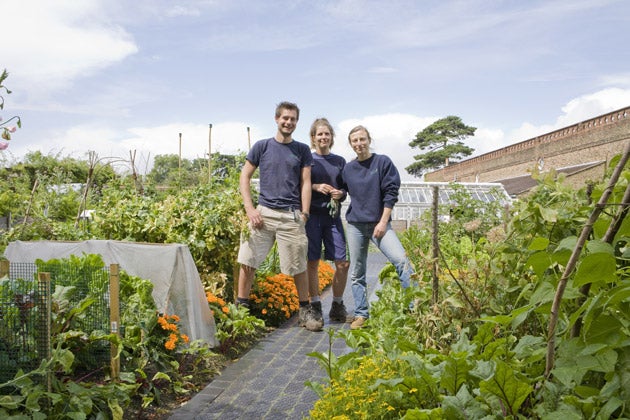A class apart: Emma Townshend goes back to school for a lesson in veg growing at Kew
The celery is perfect, the marigold edging delightful; it's an A for effort and results, says Emma Townshend, as she visits the student vegetable plots at Kew

Visitors to Kew can be caught cooing over many delicious sights this summer (and looking slightly green at others: when I'm there, there's a two-and-a-half-metre Rocky Shop of Horrors bloom in one of the glasshouses that smells of vaguely decomposed fish). But the place guaranteed to get visitors congregating and talking to each other lies hidden behind administration buildings and badger fencing: it's the student vegetable plots.
The textbook results achieved by Kew's diploma trainees can themselves be slightly nauseating to those of us with weedy allotments; but, on the other hand, there's loads I could learn from these demonstration veg gardens. Alex Summers, Sara Miller and Alison Chapman from this year's course showed me around, pointing out the individual beds they took on in January this year. "First of all you have to make a plan, and you get marked on that," they explain. "Then you have to prepare the soil, and you get marked on that. Then you get your seed allocation in March, and from April onwards you are marked every month." I start wondering whether I would manage to have a tidier allotment if someone came with a clipboard and assessed it every four weeks.
Martin Staniforth is the man with the mark sheet, and he is a mild-mannered stickler. Raking is banned. Using tools other than those specified is banned. Those who don't follow the rules will have marks deducted. But while his rules leave me quaking, his gentle enthusiasm for vegetable-growing rubs off. "Yes," he says, when I ask, "you can have a feeling for growing veg. Some people are particularly good at it. But everybody can have a go."
This is the principle behind the Kew venture, and few of the students growing veg this year have ever done it before. Alex Summers' novice patch is full of expertly grown produce, but most impressive of all is his marigold edging (he later reveals that his dad works in a Nottingham parks department – his bedding skills must be genetic). On the subject of veg-growing, though, he is now a convert: "Give it a go," is his advice. "And don't worry: expertise is something you'll build up over time."
Alison Chapman agrees: "You can't expect to start off and do perfect veg-growing in one year," she says. "You need patience. We've all had good and bad months." And for Sara Miller, there's one more indispensable tip. When I ask her how she grew the perfect celery that's flourishing in the middle of her patch, she laughs. "I just followed the instructions on the packet."
Go to www.kew.org for information
How to grow veg by Martin Staniforth
"You can't beat home-grown salad leaves, courgettes and beetroot (above). A packet of salad is £1.50. For that you can grow 200 lettuces that taste a million times better than shop-bought ones (and they never have these delicious baby beets).
"You have to be ingenious about crop protection. We've got some very frisky squirrels with a penchant for lettuce. Fleece and enviromesh are both good options. And we use companion planting, for example onions interplanted with carrots, to keep off the flies that affect both, because of the confusion of scents.
"I recommend dwarf French beans as a great crop for a small garden. The plants are small and low to the ground and if you feed them and care for them generously, you should get a really good return."
Join our commenting forum
Join thought-provoking conversations, follow other Independent readers and see their replies
Comments